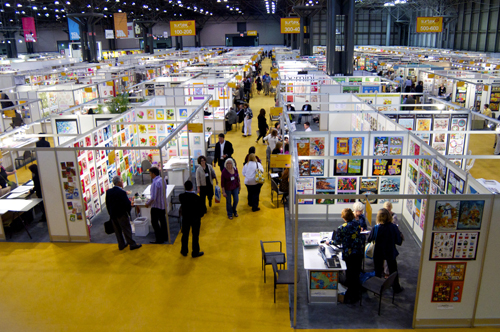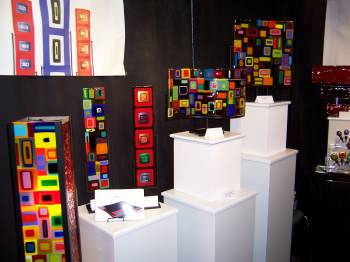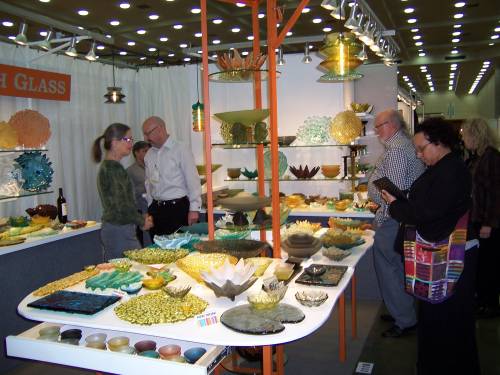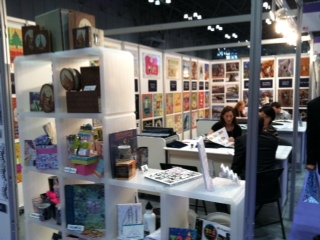By Carolyn Edlund
Headed to a trade show this year? Here’s how to close more sales.
The National Stationery Show, Surtex and The International Contemporary Furniture Fair are coming up soon at the Javits Center in New York City. Management released statistics about buyers who are attending the show. Among them are these two very interesting facts:
- NSS exhibitors generate as many as 100 leads during the 3-1/2 day Show
- 35% of attending businesses come to source, then place orders after the show
This is probably not unusual for a trade show audience. Artists and other exhibitors should be very mindful of what this means to them while exhibiting at the trade show and going forward.
Since it is very likely that a third of your potential customers won’t place orders directly with you at the show itself, you must:
Make a Memorable Impression
Do you have a show booth to be proud of? Does it invite visitors in, with an attractive professional display, smart merchandising of your work and excellent lighting?
Smart Signage. Large photos of your work (especially if it is small) can really help make your art pop. Since trade show aisles are long and narrow, strategically place signage on side walls within two feet of the front of your booth to catch the eye of visitors walking either way.
Greet your customers. Ever observe an exhibitor ignoring booth visitors, or even reading a book? Ouch. It hurts to see someone who paid a lot to come to a show making such a mistake. Give your prospects room to browse, but smile and make eye contact. Engage with them in conversation and make sure you share your story and the benefits of your line.
Gorgeous presentation. Going the extra mile to present your work beautifully will wow your audience. Plus, the more professionally your work appears, the more seriously you will be taken as an artist. Avoid clutter when displaying your work. Allow each piece to stand out by using pedestals, or grouping work in bestseller packages or suggested minimum orders. And make sure you’ve got plenty of good lighting to highlight your booth – it can make all the difference.
Gather Information
When speaking to potential customers, ask lots of questions. What type of a store do they have? What other lines do they carry? Who are their customers? What at they looking for? Are you speaking with a decision maker?
Get their business card. Whether writing an order or not, you will take their business card, and give them your brochure, line sheet, or other trade show items.” Note on the back of their card any important facts about your conversation so that your follow up will be more complete. Don’t leave a stack of brochures out on a table for anyone to take. Hand the materials to booth visitors personally to ensure that you get their card and give you more reason to interact.
Follow Up
Make contact soon after the event. Here’s where a lot of exhibitors fall down on the job. Remember that statistic? 35% of buyers plan to place orders after the show is over. If you don’t contact them within the first week or two, it’s not likely that they will call you. They will be placing orders with your competitors who did their follow up. Schedule this on your calendar as a priority, because it could be a major moneymaking activity for your business.
Close the sale. A skillful business person will get in touch with a decision maker, remind them of their conversation at the show, and talk about the customer. Yes, that’s right. Nobody likes to hear a never-ending sales pitch.
If your prospect is a good fit, talk about their needs and genuinely be of service to them. Use the information you gathered at the show to express that you understand their business and were listening. Explain any benefits of your line and talk about their buying process. Ask for the sale. If they decline, let them know you would like to keep them on your list as you develop new collections and products.
Stay in touch. It takes between 5-12 contacts to close the average sale. That means if they didn’t buy from you right out of the gate or soon afterwards, they may need to see your brand and your work a few more times – or many more times. Keep names of interested prospects on your list for several years, with regular contact every few months through a drip marketing plan. This may include emails, postcards, newsletters, studio invitations, phone calls or even a store visit if you are local to them.
You are not annoying buyers by following up with them. Every retailer is familiar with the sales process, and they frequently see reps who call on their stores. Those reps are helpful partners to the retailer, by recommending good products, giving great service and solving problems. You as an artist can be that partner as well. In fact, building a partnering relationship with your customer is an ideal scenario where both of your businesses will benefit.







Thank you for the very good information many people starting out need to know. All too often people are not prepared, our first wholesale show we didn’t even have codes for each item, you have given a great outline of what to expect.
I like your tip to make your presentation beautiful. Like you said, you will be taken more seriously if your work is set up professionally. Having a good display, interacting with your visitors, and following up after the event are key to retaining customers. Thanks for the tips!
Thanks Hazel – yep, beautiful presentation is what it’s all about!
Thanks for sharing this article with us!